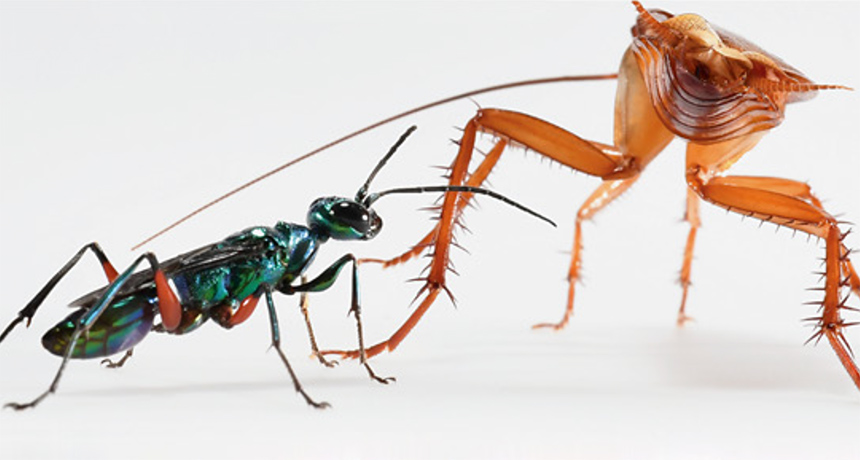How roaches fight off wasps that turn their victims into zombies
Cockroaches kick attacking emerald jewel wasps to avoid being incapacitated and buried alive

ZOMBIE FIGHT CLUB The first close look at how cockroaches defend against the emerald jewel wasp shows the importance of standing tall and kicking a lot.
K.C. Catania/Brain, Behavior & Evolution 2018
Real-life fights against zombie-makers offer plenty of tips for avoiding undeath. Just ask cockroaches, targets of the emerald jewel wasp.
The female wasps (Ampulex compressa) specialize in attacking the American cockroach (Periplaneta americana). If a wasp succeeds, she leads away an unprotesting roach like a dog on a leash just by tugging at a roach antenna. Then she lays an egg on the roach and buries the insect alive as living meat for a wasp larva. Though a normal roach could dig itself out, there’s no sign that the wasp-stung ones can even try.
To the roaches, the wasp “is a dedicated, goal-oriented, deft parasitoid coming for your brain,” says neurobiologist Kenneth Catania at Vanderbilt University in Nashville. He has recently created an impressive collection of slo-mo attack videos, providing the first detailed look at how some roaches fight back.
To avoid being leash-walked to the tomb, vigilance was vital. In 28 out of 55 attacks that Catania videoed in a confined lab space, roaches didn’t seem to notice the threat quickly. Their attackers needed only about 11 seconds on average to ease close and conquer.
Zombie two-step
A small emerald jewel wasp needs just two stings to turn an American cockroach into walking, unresisting meat. First, the wasp grasps the edge of a shield that covers the back of the roach’s neck (left) and delivers a sting that paralyzes the roach’s front legs. Then the wasp bends its body around to deliver a sting through the throat up into the roach’s brain (right). The roach will be able to walk only if the wasp initiates the movement by pulling on a roach antenna.

More vigilant roaches, however, fought back. Seventeen managed to hold off the wasp for a full three minutes, which Catania says counted as success, he reports October 31 in Brain, Behavior and Evolution. In the wild, a jewel wasp would probably give up after such a feisty fight, or the cockroach would manage to dash away.
It’s not mere ghoulish interest that fuels such research. “There’s a lot of recent interest in the jewel wasp, and for a good reason,” says Coby Schal, a chemical ecologist at North Carolina State University in Raleigh, who studies other aspects of roach behavior. Both the wasps and the roaches are relatively large and easy to experiment on for studying how behavior arises from brains and nerves.
The attacking wasp needs victims with their nervous systems still working well enough to move. Otherwise the tiny jewel wasp would never be able to get a whole roach to an egg chamber. Every wasp needs living roach meat to start life, so the evolutionary forces that hone wasp attacks are extreme, Catania says. The jewel wasp has evolved an attack that subdues a roach in just two precise stings.
For the first sting, a wasp jumps and grabs the little shield over what’s basically the back of the roach’s neck. Within literally half a second, the wasp is positioned to deliver a sting that will paralyze the front legs, making them useless for defense. The wasp then bends her abdomen around, quickly feeling the way to the soft tissues of the roach throat. The stinger itself carries sensors and stabs up through the throat to deliver venom to the cockroach’s brain.
Roaches then typically start grooming themselves, possibly as a side effect of the venom. The wasp doesn’t have to do anything else. The roach “is sitting there not running away from this really terrifying creature that’s going to eventually ensure it gets eaten alive,” Catania says. It doesn’t resist when the wasp bites an antenna down to half-length and takes a drink of the insect version of blood.
ZOMBIE MOVIE The most detailed study yet of real-life fights against zombie-making female jewel wasps shows what happens when one targets an American cockroach. |
In Catania’s experiments, luckier roaches noticed an approaching wasp. Their first most effective defensive move was what he calls “stilt standing,” the roach rising tall on its legs. It’s “almost like a barbed wire fence,” he says. While the plastic Halloween roaches Catania bought for his own kitchen have misleadingly smooth legs, real roach legs are sensitive and bristle with spines that can stab a wasp.
In another strong move as the fight wears on, a roach may turn and, with one of its rear legs, kick the wasp in the head repeatedly. A roach leg isn’t built for a straight kick, so the insect instead swings its leg a bit like a baseball bat. Juvenile roaches don’t have much of a chance in the lab arena regardless, but a full-grown adult does.
These details of roach defense now open up a range of research questions, such as teasing out how different evolutionary pressures hone defenses and attacks. For a bit of (maybe) practical advice should fictional zombie-makers jump off a movie screen, Catania offers: “Protect your throat.” Such advice is a bit late for him, though. His Halloween costume this year? Zombie, of course.
THE HORROR Emerald jewel wasps could very well be classic horror villains, but the cockroaches they stalk don’t go down without a struggle. |






